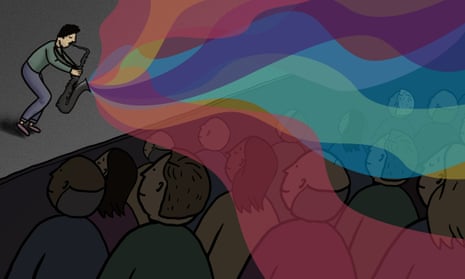Have you ever been at a concert and seen a musician or rapper start to improvise? It can often seem effortless or even magical. Few people can freestyle like Kendrick Lamar and Notorious BIG, or improvise like jazz greats Herbie Hancock and Miles Davis. What is going on in the brain during these acts of creative genius?
In recent years, several neuroscience studies have examined what is happening in the brain while jazz musicians and freestyle rappers are improvising. These studies provide a window into what is going on, more generally, in the brains of people while they are being creative.
Letting go
Some types of creativity, such as figuring out how to solve a hard maths problem or devising a novel way to get around a traffic jam, require deliberation and concentration. Other types, such as artistic expression, appear to rely on parts of the brain becoming “quieter” than usual. When they are improvising, key portions of professional musicians’ brains appear to be remarkably quiet.
This article includes content hosted on embed-ssl.ted.com. We ask for your permission before anything is loaded, as the provider may be using cookies and other technologies. To view this content, click 'Allow and continue'.
There are two main networks in the brain that are quiet – or “deactivated” – during improvisation: the default mode network and the dorsolateral prefrontal cortex (DLPFC). The former comprises a group of brain areas that are generally active when you are daydreaming or resting. It is your brain’s so-called “default” system. While you are daydreaming, you are generally thinking about yourself: reliving past events, imagining future ones, thinking about how you feel or have felt. Meanwhile, the DLPFC is involved in “executive function” – it acts as a control centre that helps with planning and conscious self-monitoring of whatever you are doing.
At first glance, it is puzzling that the default mode network and the DLPFC would be quiet when you are being creative; creativity is the type of behaviour that seems like it would require intensely focusing on yourself, planning and monitoring your actions.
Well, maybe not – research shows that the brain is shutting down your inhibitions during these creative moments. It appears that to be really creative, you need to avoid critiquing and controlling your actions, and instead, let yourself go in order to get into the moment, regardless of any mistakes.
The art of spontaneity
Although there are many areas of the brain that are quiet during improvisation, several key areas are also highly active. Professional jazz musicians and rappers have practised for so many hours that the techniques and skills they need to perform successfully become almost automatic. This expertise is reflected in their brains while they improvise.
Two areas that are consistently active when jazz musicians or freestyle rappers are improvising are the premotor areas and language areas. Premotor areas are the parts of the brain that prepare and coordinate your movements. The language areas that are active during artistic creativity are responsible for both understanding and producing language – a neural process that appears to be critical for spontaneous communication using music, whether spoken language is actually used or not. This finding is consistent with the artistic process, where a key element of musical performance or rapping is communication, as artists attempt to express an idea or emotion to their audience.
The patterns of activation in premotor areas and language areas suggest that musicians and rappers can link together many rehearsed action patterns to communicate in creative ways through their art.
Putting it all together: feeling the flow
Think of an occasion when you were so focused on an activity that you lost all sense of time. What your brain is experiencing when you get into the zone is similar to what happens in performers’ brains when they get into a groove on stage.
This feeling of being in the zone is called a flow state. When one is in a flow state, everything starts “clicking” – the activity can begin to feel effortless, and one forgets or does not notice that any time is passing. Flow states do not only happen during music performances. Playing sports or video games, writing, computer programming, painting, and many other activities can lead to flow states. All of these activities require training to gain expertise. Once you have honed a hard-to-master skill, you may perform best when you begin to feel the flow, ie, when the parts of your brain that critique and criticise are muted. The deactivations that are seen in the brains of freestyle rappers and jazz musicians while they are performing seem to be the neural signature of flow states – turning off the monitor.
Creativity is a complex, multifaceted ability that is supported by many overlapping brain networks, and not all kinds of creativity require your brain to enter a flow state. However, flow states may be crucial for getting into a groove during musical performance. It takes a lot of time and work to become an expert at anything, and shutting parts of your brain off is not the key to being the next Charlie Parker. Until you are an expert, it may be better to stay focused. But when your moment comes, as Eminem recommends, “You better lose yourself in the music”.
Charles Limb is a professor and chief of otology/neurotology and skull base surgery at the University of California, San Francisco, and a faculty member at the Peabody Conservatory of Music. Limb’s TED talk on improvisation and the brain has over 1m views.
Malinda McPherson is a PhD student on the Harvard programme in speech and hearing bioscience and technology.
- Get involved with the Use your head series by joining the discussion on #useyourhead or pitching your ideas to natalie.gil.casual@theguardian.com

Comments (…)
Sign in or create your Guardian account to join the discussion